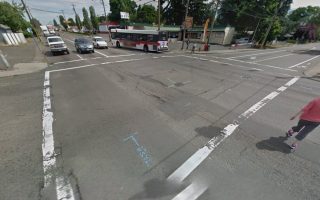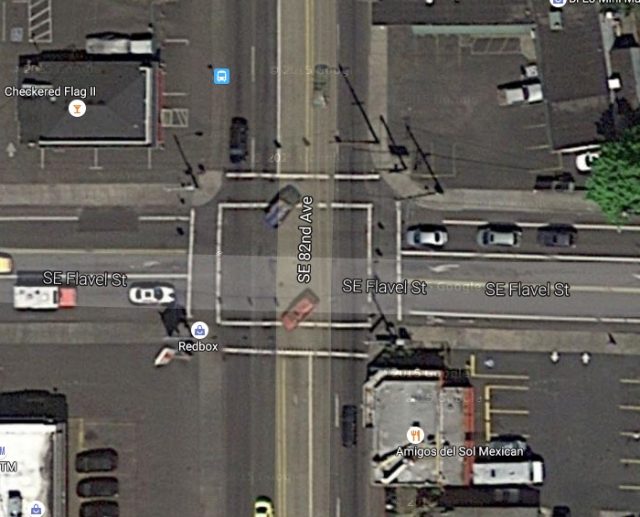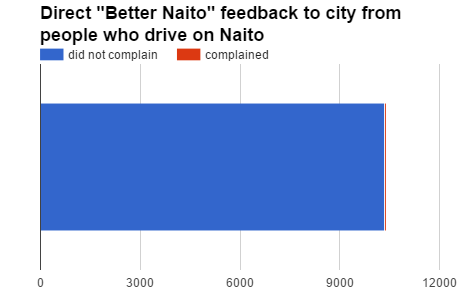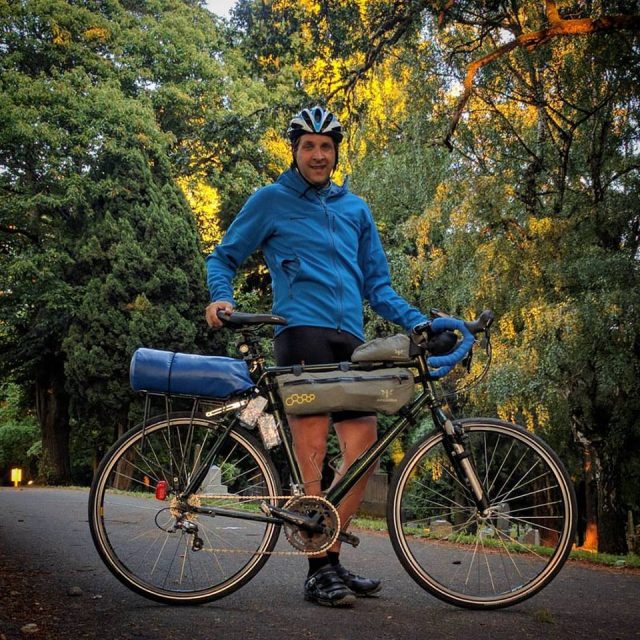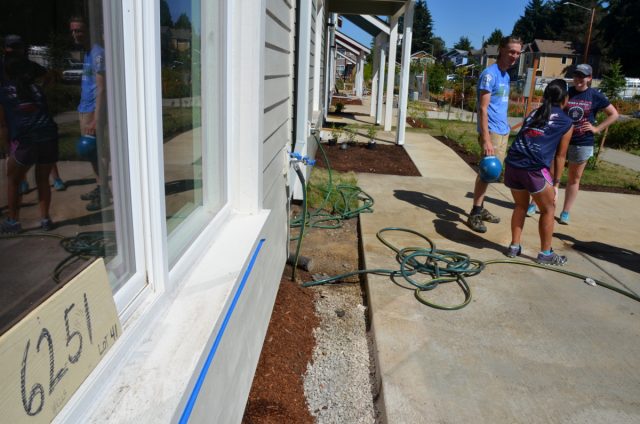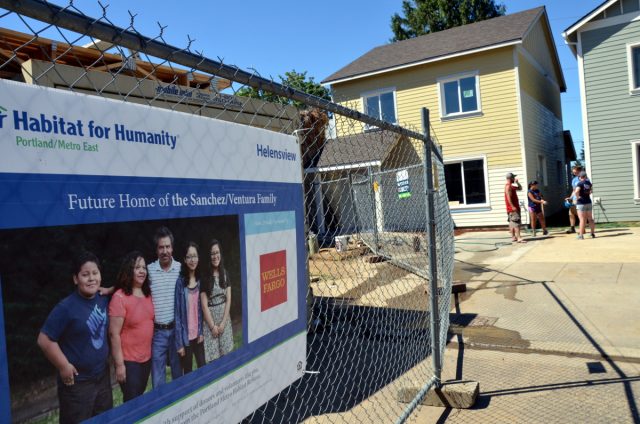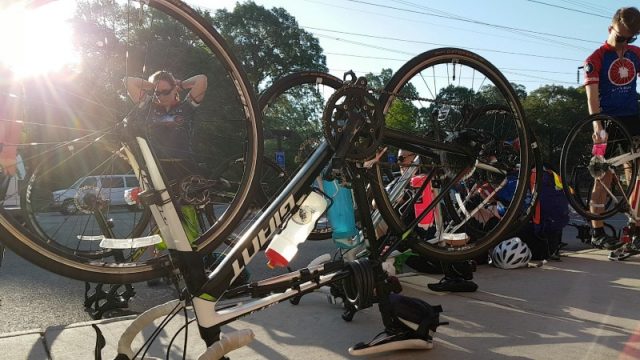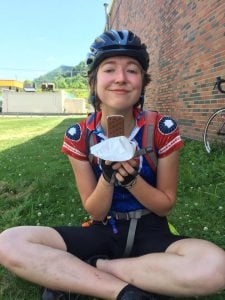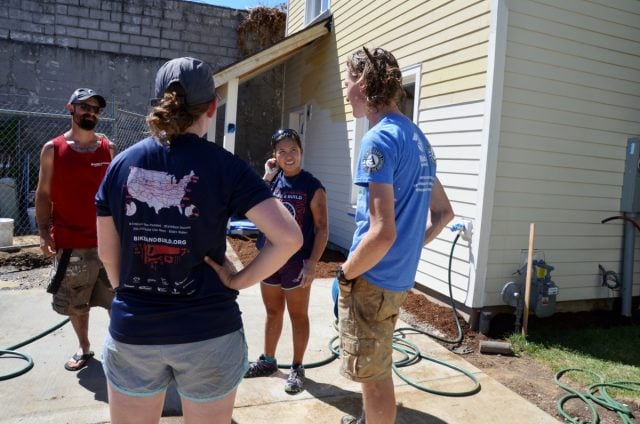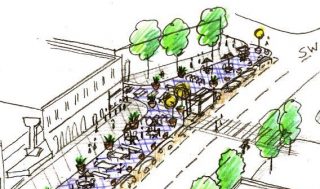
Naito Parkway on Thursday afternoon as seen looking north from the Morrison Bridge.
(Photo: J. Maus/BikePortland)
This weekend, the City of Portland plans to remove the temporary multi-use path from the eastern side of Naito Parkway so the space can be used by cars instead.
It slowed rush-hour northbound auto trips somewhat: by about 1.5 minutes in the morning and between 30 seconds and two minutes in the evening, according to an independent analysis requested by The Oregonian and published Friday. (That’s for someone traveling all the way from I-405 to NW Everett.)
On the other hand, the project vastly improved the experience of biking or walking on Naito, especially during the summer festivals in which Waterfront Park is fenced up to the edge of the curb. In past years, people typically spill into the bike lane, forcing bikes into the auto lane, and the waterfront path regularly becomes almost impassable by bike because so many people are walking there.
So for politicians, here’s the question: How do you weigh the benefits of depressurizing the waterfront path and increasing the appeal of biking and walking downtown against the costs of increasing delay for people driving?
In short: how much were people who drive ticked off by those additional minutes of delay?
Well, out of the 10,400 people who drive northbound on Naito on the average weekday, exactly 45 sent either a voicemail or an email to the city opposing the project’s congestion effects. Just for fun, let’s look at that on a chart:
“I work in Portland Monday-Friday,” wrote Paula Beard. “I drive North on Naito Parkway to Davis, then to 8th and Glisan. My evening commute has not been impacted by the Northbound Naito lane closure, but my morning commute time is greatly increased. I timed it today—25 minutes from the time I merged to Naito on the South end to when I arrived at the Davis Street stoplight. Without the lane closure it is about 5-10 minutes.”
Now, obviously there were many people annoyed by the Naito change who didn’t take the time to contact the city about the plan. Feedback like this is a better indicator of how many people are passionate about a policy — potentially to the extent that it’d influence their vote.
But in that case, we also need to consider the number of people who sent emails or voicemails supporting the project’s biking and walking benefits. We don’t have good data on how many people bike or walk on Naito, unfortunately, but a total of 65 people contacted the city since Better Naito was installed to express support for the idea. So here’s another chart:
The city also got a handful of letters and voicemails from people discussing design issues with the temporary path, such as trucks parking there or confusion about where bikes should turn. Those aren’t counted in this analysis unless they also mentioned general support for or opposition to the general change.
To be fair, all but nine of those positive comments came over the last week, when some biking advocates organized a letter-writing campaign in anticipation of the project being removed. But of course that only happened because someone was motivated to take the time to organize a letter-writing campaign … and because 56 people apparently cared enough to join that campaign even before the trial was removed.
“I’ve heard rumors that Better Naito is being torn out this weekend,” wrote Evan Heidtmann in an email to the city Tuesday. “Why would this happen? It doesn’t make any sense to me. I enjoyed riding on Naito this summer and I don’t know of anyone who wants it to go back to the way it was. Our waterfront is one of the best things going and we need to make it a great place to be, not a giant sewer for people driving fast in their cars. Everyone has already figured out how to use the street in its new configuration. Changing it now will just lead to confusion, frustration, and increased dangers for everyone on the street.”
By contrast, most of the negative feedback arrived at the start of the project; only nine of the 45 negative comments arrived in the last week.
Here are 19 more examples of things people had to say to the city about Naito, released to BikePortland after a public-records request. We’re publishing positive and negative feedback in the same ratio that the city received: about 60 percent positive.
Subject: Better, Better Naito
Dear Mayor and City Council – I have been loving the Better Naito project and had no idea it wasn’t going to become permanent! If there is a jewel of downtown Portland, it is the waterfront. I have taken family and friends there from Ohio, California, Colorado, Iowa and of course Portland, and everyone loves it. Having the security to ride and walk along more safely has been a great improvement, especially when there are thousands of people at the many events there.
What other city would do this grand experiment with traffic control? I congratulate you for conducting experiments like this and risking the wrath of other commuters. The investigative work is essentially done, and now we need to take it to the next step and make it permanent.
I love that we live in a city that is so progressive and tries things like this. And I agree with people who say we can’t really pave our way out of our new traffic problems, so where we can, let’s continue facilitating active transportation so that it becomes part of our lives.
Sincerely,
Rob Hertert
Subject: Commuting from SW to NE
Hello,
Just some feedback about clogged arteries. I am sure your office is aware of the worsening of traffic conditions in the past few years. I live in NE Portland and work on SW Macadam, a 6 mile commute by car. Whether due to new residents or tourists, the traffic on I5 and 405 has ramped up considerably. It can take 45 minutes for me to get home in the worst of the traffic jams. Naito Parkway has been an alternative option for me to use when the freeways are at a standstill. The blocked easternmost lane has created yet another traffic log jam. I see drivers taking unnecessary risks. The other day I saw a van driving down the blocked lane. The pedestrian flow was in Waterfront Park with people crossing Naito at lights or marked crossing points. I did not see people using the blocked lane as a walking space. The lane was empty. This experiment in blocking a lane of a main artery seems frivolous and potentially dangerous.
I have lived in NE Portland since 1980, long before it became trendy, and love its walkability. However, I am increasingly concerned about the liveability of the city as a whole. We have had a huge influx of people without the transportation infrastructure to move them quickly.
Jan Volkin
NE Portland
Subject: Commuter Experience
Heya! I heard your soliciting feedback on the Naito bike route.
I am a 100% car commuter. I drive from North Portland into SW downtown for work, dropping my kids off at school and daycare on the way. I don’t have time to bike to work, regardless of how nice or big the bike is …
… And I *LOVE* the bike path. It doesn’t significantly impact my commute time, I see tons of cyclists using it every day, it helps keep the waterfront pedestrian path clear and safe, and I think it’s the right thing for out growing city!!
Regarding the folks who complain about traffic snarls: in my experience, the #1 jam is the Hawthorne bridge on ramp from Naito. Everything else moves at a pretty steady clip. Opening up the Naito bike line to vehicular traffic isn’t a solution to any of the traffic problems I’ve seen. At best it’s a short term solution to the same congestion, whereas a bike path can accommodate many, many more commuters!
I’m thinking about the continuous development in the north Pearl, the south waterfront, and the upcoming inner SE — all need access, and all are extremely bikeable. Let’s set the right precedence and make our city even more friendly to cyclists …
And I say this as a 100% downtown car commuter!
Thanks,
-Peat Bakke
Subject: Please keep BetterNaito!
I’ve followed the instructions on your website and tweeted my thanks for #BetterNaito, but tonight I’ve learned that there is a chance that we can keep it.
Please, please, please! This would be great for family biking. Just last week we had a biking family visiting from Seattle and it was wonderful to be able to get to the BoltBus stop easily from the Hawthorne Bridge and then use it to connect to the path to the Tillicum. Lots of visitors want to ride the Tillicum and BetterNaito was a great, low-stress way to get there on our cargo bikes.
For those of us that don’t venture over the river to the westside very often, it’s hard to find a low-stress way to get where we do need to go. This is so helpful. My bakfiets weighs 90 pounds before the kids get in it with all their gear, so we need a flat or downhill route to get where we are going. BetterNaito lets me ride at my speed (I average 4 mph) without inconveniencing people walking or people biking faster than that. And it’s so flat!
I’m looking forward to taking the kids to Jamison Square if you keep it. I hope you do.
Thank you,
Kathleen Youell
Subject: A Joy
Hi!
Thought I’d take a moment to say how much this project means to me. Traveling between SE to NW Portland is made easier when I can stay on the East side of Naito. This makes getting on and off the bridge easier. I wish it would carry on through the winter. I typically take the Eastbank home after work in the summer but when winter rolls around it’s too dark and I take Naito. Riding South on the West side of Naito, I have to watch the parked cars since they may pull out or open doors without warning. Also, it can be stressful to get across Naito at the Salmon St fountain to get to the Hawthorne bridge.
Thank you for taking the time to read my message. Please let me know if you have any questions or comments.
Be well,
Siobhan
Subject: Please make Better Naito permanent
I just heard that the opening of Better Naito to pedestrians/cyclists/skaters is coming to an end this Sunday. This lane has made life better for so many at so little a cost. Walking down on the shared path by the water is so much safer and more welcome for the elderly and families and tourists. Meanwhile faster moving thru-cyclists, runners and skaters have taken to Better Naito to move through more efficiently without disturbing their fellow Portlanders. It really has been marvelous. I drive through here too and I have not noticed any significant change in the driving time.
There is limited capacity and growing demand for human-powered movement in this area. Better Naito eases both problems elegantly and inexpensively. This is future thinking. Please make it permanent.
Best,
William Rausch
Subject: “better naito” is not better
Regarding “better naito.” It seems like a nice idea, but really, it is a mess.
Your website has too much positive spin and doesn’t speak realistically. Fact is, delays are more like 10 minutes – you cite 45 seconds to 1 minute. Try again. I take the route daily and know this for a fact. Your website states there is a sign alerting drivers ahead of time – barely noticeable. But again – the alternate route adds 10 minutes.
Your solution only help bikes/peds even though you say “more connected way for all Oregonians.” What about people who are trying to get to work DURING A REGULAR MORNING WHEN THERE IS NO FESTIVAL? It is a ridiculous concept to create a traffic jam and a mess of construction cones during these times. How did anyone think this was smart?
A better solution that would indeed benefit all Oregonians using downtown would be to erect the lanes during festival HOURS only. Simple, efficient, smart for all.
Anita
Subject: Better Naito
Hello Mayor and City Commissioners;
I am an internal medicine physician at OHSU and bike to the tram every day from my home in NE Portland. I am writing to express my sincere and heartfelt support for the Better Naito project. Although there are certainly other areas of the city which sorely need bike infrastructure attention, I have personally experienced how the conversion of Naito the last several months has benefited a huge number of Portlanders and visitors to our great city- bicyclists and pedestrians alike. I can’t help but smile every time I bike down Naito now. Seriously!
I appreciate the hard work you all do on a daily basis for Portland (despite the complaints and grumblings of many). This project is important for you to support and I feel that it (and other bike and pedestrian friendly projects across the city) enhance what is already such a great place to live.
Best,
Joe Hardman, MD
Subject: Make #BetterNaito permanent!
Hello City of Portland representatives,
Today I write you to make my appeal for keeping the #BetterNaito changes permanent. It has been absolutely wonderful to have this dedicated cycle and pedestrian path for the last few months. I ride my bike five days a week from Inner SE to Naito and NW 9th Ave and this segment is crucial for my commute.
It has been wonderful to have this alternative bike path available, especially in the summer time. There is no easy traffic-free way for me to make an efficient north/south commute from the Pearl to the Hawthorne bridge except on this path. The festivals that take place on the Esplanade during the summer months make riding near impossible with people who are leisurely trying to enjoy those festivals and the park. Similarly, riding on the East side Esplanade is also extremely difficult. There are many people enjoying this space in a leisurely way and it does not feel very safe for me or for them to use these paths for my bicycle commute where I am often riding very fast.
Having said that, I’ll leave you with a few more points for consideration
– The four permanent lanes of auto traffic on Naito have access to the road for 8760 hours a year. I’m sure traffic volume studies show that this road can certainly afford to permanent lose a lane. Let’s get real and give cyclists a piece of that 8760 hour pie.
– The distance we’re talking about is a mere 0.70 miles. In the grand scheme of trips via automobile on this road, that is like a drop of water in the ocean. For cycling commuters, that can be a much more significant percentage of their commute.
– I ride five days a week all year long. I see the volume of traffic every day on Naito during peak hours. Northbound traffic can certainly support the change. Congestion is not that bad.
– I’ve also ridden for the last eight years using the Esplanade. I can tell you having more cyclists on this pathway will NOT work. I’ve seen it from both perspectives – as a pedestrian trying to dodge cyclists and as a cyclist trying to go to and from work. If it were not for #BetterNaito, I would simply divert to another street (3rd Ave). Riding on the bike path on Naito now really sucks, as there are at least nine traffic lights that kill my trip.
– This would be a tremendous sign of support from the city about taking cycling seriously. You’ve already got some great momentum with Biketown, closing the Naito gap, Ankeny Plaza. Keep the transformations coming!
– I’m invested in my city and my community. I am a tax-paying homeowner in Portland that wants to see my city work for me
Thank you for your time,
Evan Reeves
From: Jared Lorz
Subject: You suck
I have had to walk on dirt sidewalks and unpaved dilapidated streets for 30 years because you bastards won’t improve southwest Portland. Screw downtown and your little initiatives.
Subject: Bike lanes vs cars. Naito Parkway and foster and holgate.
You guys are idiots. If you want people to come to the festivals, more parking for CARS and lanes for CARS are needed. I used to live in portland and now won’t come to any of your festivals nor will any of my friends of family because you have let the bicyclist take over the roads that we ALL pay for. And yes I still work in portland and still pay taxes there but have moved across the river to a state that is CAR friendly for commuters.
Jason Lind
Subject: Please Keep #BetterNaito!
Hello oh transportational powers that be!
I heard through Twitter that #BetterNaito is scheduled to end on 7/31. I think this a terrible idea and here is why:
1) BetterNaito has helped to reduce car/bike and bike/ped conflicts on Naito and the Waterfront Path.
2) We are all used to it already. I drive 60-70% and bike 30-40%, and Naito seems fine to me. I often have to visit hotels on the waterfront for my job, and I haven’t seen any unusual or commerce-ending congestion, just the typical rush hour stuff that passes if you just chill for a few minutes — as we all should.
3) We don’t want to backslide into a car-centric downtown. It doesn’t make sense to say Portland is committed to #VisionZero if we are going to take away something that creates bike/ped safety!
4) There isn’t another really good north-south bike path in downtown until 14th Ave.
5) There are so many upcoming events on the waterfront throughout the fall, winter, and spring — from Portland Marathon, to Jingle Bell Run, to Shamrock Run — it doesn’t make sense to make everyone unlearn BetterNaito when it’s just going to go back in again in the summer, and when we have so many downtown events that BetterNaito helps. Let’s keep our vibrant downtown a year-round vibrant downtown!
Please — make BetterNaito permanent and help make Portland, Oregon into the multimodal utopia we want to be.
Thank you!
Emee Pumarega
Mom
Business Owner
Car Driver
Cyclist
Subject: KEEP BETTER NAITO
Hello,
I’m writing to ask that you strongly consider keeping Better Naito permanently. I’ve worked downtown for over a decade & often bike commuted from Milwaukie to downtown on a daily basis. Although the frequency of my commute has lessened I still commute using the same route every other week and often ride downtown for errands or shopping (Powell’s Books!). Riding my bike on Naito has been way too frightening so the majority of the time I’ve used waterfront park to connect from Hawthorne bridge to the US Bancorp Tower. Riding the sidewalks with pedestrians, which has become more crowded over the years, is not ideal and poses its own dangers to cyclists, pedestrians, and the wildlife (I’ve personally witnessed a goose getting caught in wheels of a passing cyclist in waterfront sidewalk)! Additionally, at lunch time I often walk down waterfront park & experience from a pedestrian standpoint the stress of having cyclists passing, especially when large groups of people are congested in particular spots. Riding waterfront park during any event is almost impossible with limited access to reach the streets, fence obstructions, and vendor trucks/cars on sidewalk.
I had actually forgotten Better Naito was set up this year when I commuted into downtown one morning. How refreshing to be able to safely ride down Naito all the way to work (while shaving several minutes from commute time)!! I have since been able to enjoy Better Naito with my 8yo son, with groups of friends riding to events at Powell’s Books, and many other regular commutes to/from work. I have twice helped lost strangers find & ride Better Naito with me as a better way to reach Hawthorne Bridge or the Tillikum Crossing. Their response has always been “this is great!” and my reply is always “yes, it is!”
I do own & sometimes commute into downtown by car. There’s always the “change pains” as people get used to anything different but people adjust quickly & I’ve experienced little change in my car commute due to Better Naito. Additionally, I have other options in my car but I don’t have many other options on my bike!
Keep the positive change momentum going for our city & allow Better Naito to stay. Safe streets & spaces for PEOPLE (not just people in cars) is important to me.
Thank you.
~Kelly Williams
Subject: Better Naito
Dear Portland,
I want to throw my support behind better naito, the expanded bike lanes and pedestrian access has been awesome.
Let me start by saying I am not a Portland resident. I am a frequent (monthly visitor to Portland because I LOVE what an amazing city the people of Portland have created.
Why do I come every month and stay downtown and spend money?
Do you realize that in the last 25 years Portland has transformed into one of the most unique and amazing North American Cities?
1. I can take MAX from PDX to downtown and then get around on public transit
2. I can now get bikeshare, but before rent bikes and get all over most of the central city without any hassles
3. I can walk to a lot of areas of downtown easily and without hassle.
Do you realize how UNIQUE that is in north America? Only New York City and Chicago offer those same options.. possibly San Francisco, but they’re Californians.
Please keep on being amazing and keep Naito with less cars.. it is an obstacle for bikes and pedestrians to get to the waterfront and yes that bike lane is an awesome North-South route between bridges.
Thanks for being awesome and please stay that way! Keep or reinstate better Naito!
Regards
Mike Cipriano
Subject: Naito Parkway Lane Closure
Dear City of Portland Officials,
I am a 21 year resident of the City, having lived in SW Portland (close-in) for the first 9 years, and in the Alameda neighborhood for the past 11 years. When my wife and I were looking for a home in close-in NE to raise our children, we chose to live on bike way – we are proud supporters of shared transportation resources, and appreciate the relatively new bike/ped-only arrangement the City constructed next to the Madeleine School. For years, I commuted to work by bike whenever possible. Now, I work in SW Portland close to Lake Oswego, and must commute by car.
Due partially (perhaps mostly) to people moving to the Portland area, my evening commute has, rather quickly, worsened from about 40 minutes (1 1/2 years ago) to about 50-55 minutes today. I select my route depending on the day, but find that the Interstates have become unbearable, particularly when I-5 is backed up from Barbur Blvd to the Washington border. One of the routes I take is North on Naito Pkwy, crossing the river at the Steel Bridge. Unfortunately, the summer lane closure on Naito Blvd has created traffic congestion that has worsened commutes even more.
I have been an ardent supporter of the City, and have never complained. However, the Naito Pkwy lane closure does not make good sense to me. I have read through the Better Naito materials, but can’t understand why closing one lane to vehicle traffic solves the problems that the closure is intended to solve. A wonderful bike/ped facility already exists along the river bank, very close to Naito Pkwy. Why do we need two North-South bike paths so close to one another? My experience has been that the bike lane next to me is rarely used. I believe that this is a poor use of a valuable and important transportation resource.
I have witnessed many times pedestrians gingerly walking on the curb or in the painted bike lane during waterfront events. This is obviously a dangerous and unacceptable situation. But, the question is; why not move the barrier on the West side of the event venue farther to the East, creating a path in the park for pedestrians to safely travel to/from the event? Why does the event venue barrier have to abut the roadway? Bikes can continue to use the river side path. Further, the event venue can be reduced in size to accommodate a pedestrian path along side Naito Pkwy. A fence could even be erected to keep pedestrians from wandering into the roadway.
In light of the ever increasing gridlock around this City, closing important arterial streets to vehicle traffic should be avoided. In the case of the Naito Pkwy lane closure, a valuable and needed roadway is being blocked to address problems that could be addressed in other, more effective, ways. I request that the City reconsider this short-term and potentially, long term lane closure, and look at other options for addressing pedestrian and cyclist safety during summer events.
David Carter
Subject: Naito Pilot Feedback
Hello,
I would like to provide feedback on the Naito pilot. While I respect and understand the concept of increasing the ease for bike commuters, it is not possible for all of us to bike to work. Even though I am a resident of Portland and Multnomah County, I need to drive to work due to job requirements (the ability to travel to meetings in Salem and other locations with little notice) as well as childcare restrictions/hours. The lane closure has nearly doubled my commute time and increased my carbon footprint notably. Alternative routes require me to backtrack and idle more than the commute I previously took via two open lanes on Naito.
I find it additionally frustrating that I have been run off the sidewalk twice and hit by one bicycle while jogging on the waterfront during the lunch hour in the past two weeks. Even with the loss of the lane and increased commute time to give the bicycles an alternative route, I do not see bikes using the lane when I do take Naito and I have not seen a decrease in bike traffic along the waterfront walkways.
Please consider what the convenience of even more bike lanes (there are already bike lanes on both sides of Naito and a bike/walkway through the park) is doing to hard working families who are already doing what they can within reason for the environment and attempts at reducing road time. I hear my shared frustrations regularly from coworkers and friends. – I beg you not to chase honest hard working people and families out of Portland.
Thank you for providing the opportunity to voice my concerns and frustrations as a Portland native, Multnomah County tax payer/homeowner, and participant in paying the increasing fuel tax.
Respectfully,
Gail Hammer
Subject: Naito Parkway Improvements
Hi Commissioner Novick,
I am very excited to see the improvements made to Naito Parkway! Thank you and PBOT for your support on this project. I do think it is essential to make the Better Blocks project permanent as well, even if it is temporarily just paint and/or cones. I envision an easy to use bikeway for all ages starting from the S. Waterfront extending all the way to Naito and NW 17th. This would enable easy access from east of the Willamette to anywhere on the west, whether it be NW 21st/23rd, the Pearl, Downtown or the South Waterfront. Essentially, this would form the backbone of downtown’s protected bicycle network. Maybe this is your vision too. I’m excited for the many great things coming to Portland. Thanks for your leadership.
Sincerely,
Alex Gerace
Subject: Stop the insanity!
Seriously……A group of PSU students come up with a concept plan which calls for the closing of ½ of one of our city’s major arterials. The arterial which allows drivers to bypass the city’s congested core. It is tested last summer during three weeks of generally lower traffic volume due to summer vacations and such. The “Better Naito Summary Report” indicates that north bound traffic is only affected by 45 seconds to 1 minutes with the heaviest delay between Clay and Main due to the merging traffic.
Well, I would like to share with someone my experience of yesterday and today since the closing of Northbound Naito. I work in the Koin Tower on Clay. I commute in my car via Barbour Blvd. I use Front/Naito and turn right onto Clay. Yesterday the traffic northbound was stopped and heavy just north of SW Sheridan at 8:02am. I was able to finally turn left onto Clay at 8:15am. 13 minutes. Today, same route, traffic stopped and heavy just south of SW Sheridan at 8:12. I turned left onto Clay at 8:27. 15 minutes. There is a very large amount of traffic now attempting to turn off of Naito onto Clay and the other westbound streets leading into the core area to apparently attempt to avoid the delay on Naito.
$1.5 in the Mayor’s budget to screw things up. Here is a concept. Spend the money on……wait for it……a sidewalk next to the roadway. Why have we always had grass right up to the curb? Don’t take the road away. Lose ten feet of the grass and make everyone happy.
I can appreciate the difficult job you folks at PDOT have trying to make everyone happy, while at the same time building and providing a system that functions well.
I am certain that your department is monitoring the situation. Please use my input as constructive criticism.
Regards,
Neil Jaques
SW Portland Resident
Subject: PLEASE MAKE “BETTER NAITO” PERMANENT
Dear Mayor Hales and Commissioners Fish, Fritz, Novick, and Saltzman:
With only a week left before it is scheduled to be removed, Better Naito pilot project should be retained indefinitely. Further, I encourage you to find and allocate the funds to permanently transform as much of Naito Parkway as possible for safe use by non-motorized transportation modes (pedestrian, skateboard, roller skating, bicycling, etc).
Tom McCall Waterfront Park is emblematic of our City’s historic efforts to reclaim auto thoroughfares for non-motorized public use. Extending this into Naito Parkway today extends our commitment to Portland’s car-free future.
Making Better Naito permanent is also desirable for the following reasons:
• The existing multi-use path along the waterfront is increasingly overcrowded. An alternate pathway will prevent potentially dangerous collisions between pedestrians and more quickly moving skaters and cyclists.
• Naito Parkway eventually narrows to one-lane only 7/10 of mile further down the road; we’re not reducing congesting, only postponing it.
• This is a low-investment infrastructure project with immediate, high-visibility benefits.
• The economic impacts will undoubtedly be net positive for merchants on this street and connecting streets on the eastern edge of downtown. Very little freight passes through this corridor. • • Locals and tourists alike will enjoy Naito Parkway as a recreational promenade, which is far more lucrative for our city than a commuter thoroughfare.
• Our streets in the city center should be for people first, not cars. Single-occupancy vehicle driver preferences should no longer be prioritized in our city’s transportation decision-making.
This repurposing of Naito Parkways is in line with our Comprehensive and Climate Action Plans; please, let’s put our words into action.
Thank you for your service to our city and your consideration in the matter,
Sarah Iannarone
— Michael Andersen, (503) 333-7824 – michael@bikeportland.org
Our work is supported by subscribers. Please become one today.
The post Who’s mad and who’s glad about ‘Better Naito’? appeared first on BikePortland.org.

from Front Page – BikePortland.org http://ift.tt/2akBgiA
